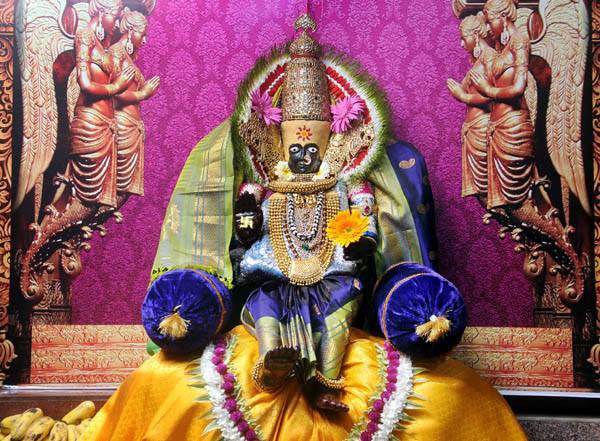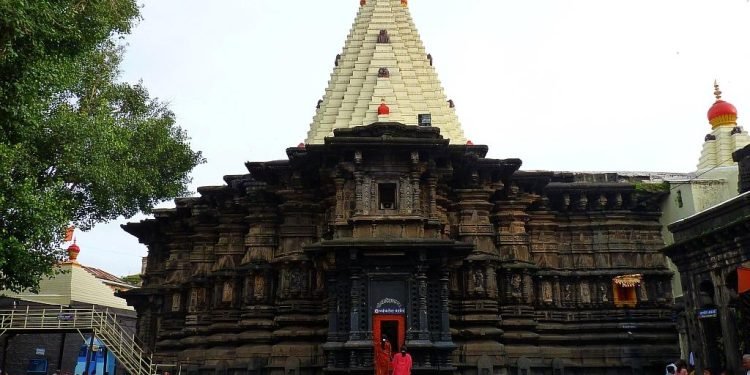Kolhapur is located in Kolhapur district and is well connected with Pune, 240 km north. It is on the national highway between Bangalore and Pune. It is situated on the banks of the Panchganga river and is full of ancient temples and shrines. Goddess Mahalakshmi resides in Kolhapur, and is been a famous holy place right from ancient times pilgrims from far and near have continued to flock here in their thousands year after year.
Shrine’s History
Temple of Goddess Mahalakshmi was first constructed in Kolhapur in Chalukya period This is evident from the style of the idols sculpture. Also, some historians state that Goddess Mahalakshmi in the form of an idol was consecrated in Kolhapur temple during the reign of King Manglesh from the Chlukya Dynasty. However, the ancient temple was destroyed by an earthquake that took place in the 8th century A.D. Yet several ruins of the first structure are found today in various part of the current temple.

Legends Associated with This Shrine
It is said that both Shri Lakshmi and Shri Vishnu reside in the Karveer area eternally and shall not leave even at the time of Mahaprayakala. This region is therefore also referred to as an avimuktakshetra. Karveer region is eternally blessed and is believed to be heldMahalaxmi_of_Kolhapur by Mother Jagdambe in her right hand, and so this region is protected from all destruction.
Lord Vishnu himself adores this region more than Vaikuntha or the Kshirsagar since it is the home of his consort Lakshmi. According to popular legends, Mahalakshmi left Vaikuntha and arrived at Kolhapur on hearing that Lord Venkatesh (Vishnu) her beloved husband failed to take action against sage Bhrigu for his horrific behaviour towards him. An angry Mahalakshmi is said to have observed strict penance in Kolhapur for several years until upon hearing the news of her husband being married to Tirumala Padmavati, another avatar of Mahalakshmi.
The greatness of this region has therefore attracted many sages and devotees, the blessings and affections showered by this region on its devotees are immeasurable. It is believed that Prabhu Shri Dattatreya still comes here every noon to seek alms.
Architectural Relevance of This Shrine
The temple dates back to Circa 600 to 700 A.D. constructed during Chalukya reign. Though the temple was built by the Chalukya ruler, Karandev, it was the Shilahara Yadava who extended and beautified it. The Mahadwara ? main entrance of the temple is the in the west with lots of small shops selling items for the worship of the Devi. Walking further down the Mahadwara one is confronted with several deepa maalas on either side, then comes a large open hall of timber construction.
The huge square pillars and foliated arches in wood are characteristic of Maratha temple architecture. This Mandap is called as Garuda-mandap and was constructed during the eighteenth century. An image of Garuda, the vahana of Vishnu, is housed in this mandap so as to face the sanctum. Adjoining it towards the east is a small mandap of stone construction. It is built on a raised plinth. An image of Ganesh nearly four feet in height stands in the centre facing the sanctum. In the central shrine, facing the west stands the Ambabai. The northern shrine is occupied by Mahakali, the southern by Mahasaraswati. Also seen in this temple is a rich display of sculpture of figurines in dancing poses, musicians, Gods and Goddesses. The three sancta have rather simple shikharas of brick and mortar dating back to the 19th century. An extremely unusual position is occupied by a Shiva ling. Immediately above the garbhagriha of the Mahalakshmi shrine is the second storey. Here a Shiva ling and a nandi are placed, it is still a mystery as to when and by whom it was placed. The image of the Goddess has an extremely pleasant appearance. It is carved in black stone, is about three feet in height and has four arms and crowned Goddess made of gemstone and weighs about 40 kilogrammes. It contains matter mixed with Hirak bits.
The typical ayudhas of the devi are as follows. In the lower right hand is the matulinga, a fruit not unlike the ordinary lemon, but much larger in size. In the upper right hand are a large mace, kaumodaks, and its head touching the ground. The upper left-hand holds the shield or khetaka, the lower one holding a bowl i.e. panpatra. There is a natural Padma-Ragini? (Lotus). On the crown of the devi are a cobra-hood and a Shiva-ling with a yoni around it. Standing behind the devi is her vahana-a lion.
The iconographical descriptions of the Goddess, going back to the thirteenth century or even earlier according to some authorities, resemble most of the lakshanas of the present image. The earliest mention comes from the Vishvakarmashastra as quoted by Hemadri in his Chaturvargachintamani. It refers specifically to the Karvirvasini Mahalakshmi.
Shrine’s Map Location and How to Go There
By Road
Kolhapur is nearly 400 km from Mumbai, 240 km from Pune. Kolhapur lies on the NH 4 between Bangalore and Pune.
By Rail
By Rail: Kolhapur is nearest Railway Station (5 km away), there are regular trains from Mumbai to Kolhapur.
By Air
Mumbai and Pune are well connected by domestic & international airlines. One can either take a train or bus to reach Kolhapur from Mumbai and Pune.
Shrine Timings
Sevas/PoojasMahalakshmi_temple,_Kolhapur Below is the daily schedule of temple ? 4.30 am to 6.00 am ? KAKADARATI 8.00 am ? MORNING MAHAPUJA 9.30 am ? NEVAIDYA/HOLY FOOD 11.30 am ? AFTERNOON MAHAPUJA 1.30 pm ? ALANKAR POOJA 8.00 pm ? DHUPARTI 10.00 pm ? SHEJARTI
Events Celebrated at This Shrine
Navratra Mahotsav Rathotsav Kirnotsav or festival of Sun rays is celebrated when the sun rays fall directly on the deitys idol at the time of sunset on the following days : 31st January Sun rays fall directly on the feet of the deity. 1st February Sun rays fall directly on the chest of the deity. 2nd February Sun rays fall directly on the entire body of the deity. 9th November Sun rays fall directly on the feet of the deity. 10th November Sun rays fall directly on the chest of the deity. 11th November Sun rays fall directly on the entire body of the deity.













































